#* general: citations / RELEVANT REFERENCES.
Explore tagged Tumblr posts
Text
[remove paywall link]
“A few of us had noticed the prevalence of unnatural writing that showed clear signs of being AI-generated, and we managed to replicate similar ‘styles’ using ChatGPT,” Ilyas Lebleu, a founding member of WikiProject AI Cleanup, told me in an email. “Discovering some common AI catchphrases allowed us to quickly spot some of the most egregious examples of generated articles, which we quickly wanted to formalize into an organized project to compile our findings and techniques.” In many cases, WikiProject AI Cleanup finds AI-generated content on Wikipedia with the same methods others have used to find AI-generated content in scientific journals and Google Books, namely by searching for phrases commonly used by ChatGPT. One egregious example is this Wikipedia article about the Chester Mental Health Center, which in November of 2023 included the phrase “As of my last knowledge update in January 2022,” referring to the last time the large language model was updated. Other instances are harder to detect. Lebleu and another WikiProject AI Cleanup founding member who goes by Queen of Hearts told me that the most “impressive” examples they found of AI-generated content on Wikipedia so far is an article about the Ottoman fortress of Amberlisihar.
[...]
“One small detail, the fortress never existed,” Lebleu said. Aside from a few tangential facts mentioned in the article, like that Mehmed the Conqueror, or Mehmed II, was a real person, everything else in the article is fake. “The entire thing was an AI-generated hoax, with well-formatted citations referencing completely nonexistent works.” Fake citations, Lebleu said, are a more “pernicious” issue because they might stay undetected for months. Even if someone was using an LLM trained on a corpus of data relevant to the Wikipedia article, it could generate text that reads well and with correctly formatted citations of real sources, it still wouldn’t be able to correctly match a citation to a specific claim made in a specific body of work.
55 notes
·
View notes
Note
I have a stupid question. How do you find out about current history scholarship and research? I am sick of reading books I've read a hundred times and were published decades ago. Is there like a forum or something where historians share research or lectures or things?
Not stupid at all!
The key is 1) knowing which sources provide the most up-to-date information, and then 2) using the appropriate strategy to access them.
Conference and lectures
Conferences are where you find the most cutting-edge research – usually work that has not been published yet, or is still in progress. Accessing conferences can be both expensive and difficult (if they're limited to people with certain affiliations, for example), but there are also conferences that are free for the public, and ones run by groups like the Organization of American Historians that are reasonably priced for the digital attendance option. You can browse conference programmes (here is the OAH's 2024 version) to at least find the names of academics relevant to your field of interest, which will help with the kinds of searches you will want to conduct below.
Finding these is a mix of luck and effort. You can set a search alerts on various platforms, literally just do a search for "[topic] academic conference", find relevant organisations and subscribe to their newsletters for updates, or do some browsing on social media. I found History Symposium (free, current, deep-dive history lectures and a virtual conference) because of something shared here on Tumblr. Following the Instagram account of the Powder House in Charleston keeps me updated on their history lecture programming (which host virtual talks including showcasing new research on the US colonial era). Then there are institutions like the Royal Museums Greenwich who publish a range of high-quality historical content on their YouTube account (they have a good series on black history and the Transatlantic slave trade, as well as a fascinating recent lecture by a historian on the queer history of the British navy, which I also found here on Tumblr).
Academic journals
Journals are where you get the most recent published academic scholarship. A journal article generally is a fairly narrow/focused exploration of a topic that adds something new to the ongoing academic conversation (e.g., a new discovery, a new analysis of existing material, a new theoretical perspective, a challenge to a previous author's work).
Other useful kinds of journal content are book reviews, as well as "review" articles, which summarise and synthesise recent research in a field – as well as newly arising questions and research directions.
Getting your hands on articles requires two steps: 1) finding the research, and 2) accessing the research.
Finding articles
For better or worse, the best generalist search tool for journal articles is Google Scholar – it allows you to search across hundreds of databases and independent publishers for relevant content.
If you're a member of a university library (not necessarily staff or student – check if your library allows external membership), it will have its own search tool which allows you to find material in the databases and journals that the university is subscribed to. Individual databases, archives or publishers (think JSTOR) will also have their own internal search.
My advice is to start your search as narrowly as possible, and then expand out slowly if you don't find anything relevant. So, for example, I might start my search with "same-sex relationships london 1780s", and if nothing comes up, I might broaden it out to "england" or "late eighteenth century", and so on.
The other thing to do is follow citations (i.e., who referenced what?). You can travel "backwards" through the literature by looking at the reference lists of books or articles you already have (in other words, which works the author used to base their research on).
But you can also travel forwards – the "cited by x" link below a reference on Google Scholar is your friend, because it shows you who used that particular source in their (by default, more recent) work.

Accessing articles
Unfortunately, a lot of academic research is gatekept by the academic publishing industrial complex – not by academics themselves, to be clear. This results in those ludicrous charges for single papers:

(And $30 is hardly the upper limit...)
But hope is not lost! You still have some options if you're willing to do a bit of work.
1) Sometimes, if you're lucky, the article will be freely available online. In Google Scholar, for example, check for the "PDF" or "HTML" link to the right of the title:

Some entire journals are freely available (usually called "open access") – one example is the Journal of the American Revolution. You can also search on DOAJ for open-access-only articles and journals.
2) I've also occasionally found the article just by googling "[article name] pdf". Some scholars will make these available for free on their personal websites, for example.
3) You can also try contacting the scholar directly through a platform like Academia.edu. Find the article there, and check if there is a "request full-text" option on its page (or, even, if the full text version has already been posted).
4) For slightly older articles, try searching on JSTOR, which gives anyone with an account free access to 100 articles a month. (I say "older", but there's even scholarship from 2024 on there these days.)
5) If all else fails, definitely do not type "sci hub" into your search engine and check there. That would be bad and naughty and very, very sexy of you. I repeat, do not do this. 🤫
Academic books
Books are not usually a great source of super-current research, both because the format doesn't lend itself to it and the publishing cycle can be very long, but they can be an excellent source for a decently recent and detailed overview of the topic. Note that you specifically want academic books here (not the ones in the "history" section of your local chain bookstore).
If you've done some digging in journal databases, you should have a good sense of which authors are writing about the topics you're interested in. Find their websites or social media feeds and subscribe to get updates on their latest work. For example, historian and Tumblr darling Joanne Freeman has a website with links to her books, lectures and podcast, as well as other media. The Museum of the American Revolution has a "Read the Revolution" speaker series featuring newly published books on relevant topics (and they're certainly not the only museum or public institution to do this). Their newsletter will keep you updated on the upcoming sessions, and the website often has a free recording of the talk available.
The prices can be quite extortionate, so again, see if you can find a free version online using the methods above. You might also have some luck finding the book on Archive.org (which might allow you to loan it out for free for an hour at a time) or Google Books (which sometimes shows you a decently large preview). Definitely do not type "libgen" into your search engine and try to download the book form there.
In summary...
There's a lot out there. A bit of persistence and a lot of searching (on databases, social media and the internet in general) will open up a huge spectrum of intereting and relevant resources!
37 notes
·
View notes
Text
(AO3)
There are no books banned from the Great Library of Tirion. There are, however, books which are generally agreed to be dangerous to read. There is a section for them, officially called “Unadvised” and informally called “Cursed Knowledge”, “Shelves of Spiders”, and “the Things The Valar Don’t Want You To Know section.”
There are no spiders in it, Dark or natural; the library staff are careful of that. There are many tomes, scrolls, and other writings which are literally cursed.
There is a slim, perfectly natural volume bound in pale grey leather like any other publication from the Metaphysical Studies department of Tirion University. It is notable only in its contents, described by its title:
The Craft of Necromancy
A study of the manipulation of fëa in life, death, the terrible neither and the tormenting both.
A note from the single author on the fourth page, after the title page and publication information, reads,
On sources and citations in this volume:
This is, I must confess, an unusual study. For one thing, while I wrote it for classic philosophical principle, that knowledge closely held ought be shared instead, I also wrote it for the relief of that sharing, as advised by acquaintances wise and well-versed in healing. To my loving advisors: I was perfectly fine before, but I do feel even better now. I’m glad you’re satisfied.
I do not believe this affects the rigor of the discussion herein. I only share it because context is always part of knowledge that ought be shared, to maximize understanding.
More relevant to the question of academic rigor is: where possible, I have included standard citations of other works on the topic, academic, biographical, and other. However, most of my knowledge on this topic was gained firsthand, either through personal experience, tutelage, or both (demonstrations upon my person, patiently explained before, during and after), and I can provide no verification save my own memory and the reputation of my primary tutor.
My memory has been confirmed to be clear by nurses of the Gardens of Lórien. My tutor has been known by many names, among them, Gorthaur, Lieutenant of Angband and Lord (and creator) of Werewolves; the Necromancer of Dol Guldur; the Lidless Eye; and Sauron the Deceiver.
Despite the last, I have perfect confidence that he was not lying to me anymore by the end. He enjoyed showing off too much for that.
With that in mind, I hope you will forgive my academic negligence in referring to him henceforth only as “a source.” It is a matter of not humoring his ego, even after his dissolution.
All that said, I have endeavored throughout this study to clearly distinguish not only between fact and theory, but between facts which I can verify through personal experience (eg, the trapping of a fëa within its hröa past the reasonable point of death), facts which were expounded upon to me at length but which I cannot confirm beyond my certainty of the source’s genuinity in his intentions to taunt and/or tempt me (eg, the warping of a fëa to suit a hroä other than that its natural own), and facts which were told to me, or to others of my association, in contexts of deception but which were later re-examined for truth (eg, on the binding of one fëa [or ëala] to another). As with any work, readers are encouraged to take the knowledge enclosed herein and make their own interpretations—though I do NOT advise practical experimentation with these matters.
This study should be taken as my final word on the matters therein. While I usually applaud curiosity and thoroughness in investigation, do not seek me out with questions.
Additionally: in light of the sober and sometimes disturbing contents of this study, I have been advised by my editor to reassure the reader (somewhat redundantly, I would argue) that I did, in fact, escape the captivity of my primary source, and I am thoroughly and happily recovered from the various torments, betrayals, etc. inflicted upon my person. My source (and tutor, creative collaborator, friend…) is confirmed to be, at the time of this publication, reduced to a scrap of a shadow soon to fade utterly from the world that is, thanks in large parts to the efforts of others. For accounts of those heroes, I recommend “The War of the Ring: A Hobbit’s Very Extended Journey There and Back Again”, B. Baggins, F. Baggins; “Nine-Fingered Frodo and the Ring of Doom”, trans. B. Baggins; and “Garden Plants of the Western Shire”, S. Gamgee.
I recommend the last particular for aspiring gardeners. My floral and herbal window-boxes are all flourishing with the advice of Mr. Gamgee.
Yours in scholarship,
Celebrimbor Curufinwë
The volume is about 100 pages, mostly text with a handful of illustrative drawings scattered among the chapters. In the space in the back pages reserved for commentary from early readers, there is only one comment:
Concerningly accurate throughout.
– Aulë
#the silmarillion#second age shenaniganry#aman ever after#celebrimbor#for emotional presence I should also tag#annatar#sauron#my fic#ficlet#I JUST THINK CELEBRIMBOR SHOULD GET SOMETHING FROM THAT WHOLE EXPERIENCE#AND WHAT HE SHOULD GET IS FURTHER ENHANCEMENT OF HIS ABILITY TO BE A SUPERVILLAIN#NOW VIA EXTENSIVE (UNPRACTICED) KNOWLEDGE OF HOW TO DO NECROMANCY#listen look me in the eye and tell me half the torture wasn’t just the ongoing villain monologue#that was half parody of the teaching and intimacy they’d once had#and half promise that they could have it again if only Celebrimbor stopped being so UNREASONABLY stubborn
354 notes
·
View notes
Note
What do you think of this anti endo's response here?
https://www.tumblr.com/cloudpeoplesys/756660678138413056/if-a-theory-is-still-heavily-backed-its-going-to?source=share
In short, it's bad.
In long...
It's really, really, really bad.
Might as well get into it.

I agree with the first part that most academic sources are reliable until disproven. We'll get back to how they're misapplying the structural dissociation model later.
Although this post is already instantly concerning in that they're implying a New York Times article is unreliable because it's not on a .gov domain. This is American Middle School-level thinking.
And they're cherry-picking the few sources that are that old, when most are from the last decade and many as recent as last year
It should also be noted that there's a big difference between news sources and scientific sources when it comes to age. The 1979 NYT source is for the Dalai Lama, the highest authority in Tibetan Buddhism, stating that religions the West could use their meditations. While older scientific sources may become less reliable as new findings emerge in the field, a quote from the Dalai Lama is going to be relevant until the Dalai Lama says something that suggests his opinion has changed.

Basically, this seems to be in reference to the Youth and Policy Center saying their editors don't have time to make detailed corrections.
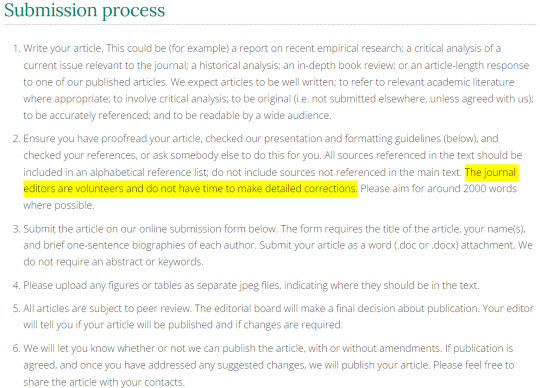
It does NOT say editors won't check to see if the sources are reliable. Just that they won't make detailed corrections themselves.
They also conveniently gloss over the fact that it's stated all articles here are subject to peer review.

Like I said. Middle school-level thinking.
This is just completely untrue, and grown-ups in higher education learn to check the reliability of the publications. Not the domains that happen to host the articles.

In general, sure. 🤷♀️
But social media posts, for the most part, are reserved for the community explanations section and parts about plural history. Not treated as academic sources.
Actually though, why is Reddit listed first? That kind of jumps out at me, because Reddit isn't sourced very often, and I think it's actually referencing the AMA with Dr. Lifshitz and Dr. Luhrmann.
I'm not certain, but this seems a popular conspiracy theory with anti-endos who are in denial about this study. The theory basically goes that the AMA isn't real and the people behind it are just pretending to be doctors.
Something which is absolutely wild when both are names of real people who have published works, including studies into tulpamancers.
Essentially, for the AMA and the FMRI study to be fake, you would have to believe that mods of multiple tulpa communities coordinated for years to create an elaborate hoax where they started gathering participants for this fake study in 2019. They created multiple accounts to pretend to have participated in it. They then faked an entire AMA by impersonating these very real doctors, knowing the entire thing would come crashing down if either real doctor found out they had been impersonated. And this would damage future research, because again, they have both published works about tulpamancy.
It's difficult to put into words the sheer ridiculousness of such a belief. It's frankly on the level of Q-anon conspiracy theories.

I don't know what "medium section" it's talking about.
The first article that mentions mediumship in the document is Dissociation in Trauma: A New Definition and Comparison with Previous Formulations.
This is cited by 177 different articles.
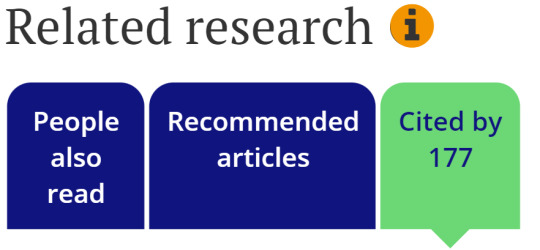
(I'll talk more about this later. Don't forget that article.)
The next one about mediumship, Comparison of brazilian spiritist mediumship and dissociative identity disorder, is cited by 16. (The results say 17, but one of those is the article itself. No clue why it's counted as citing itself.)
The ones with fewer citations are, unsurprisingly, newer papers.
It's likely that most papers published in the past few years won't have many citations.
Which is a bit of a catch-22.
Sources that are too old, anti-endos will say aren't valid because of how old they are. But new sources are bad because nobody has cited them. It's a great tactic if your goal is just making up excuses to pretend none of the evidence against you is real.
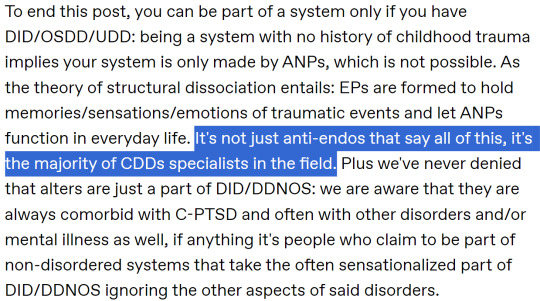
Yes, finally, we reach the end where we can talk about how sysmeds don't actually understand the theory of structural dissociation.
Let's take a step back and revisit that article, the first one to mention that mediumship in the document, that had 177 citations.

They may, if they looked, recognize these names. Because they're two of the same names from the first source they posted:
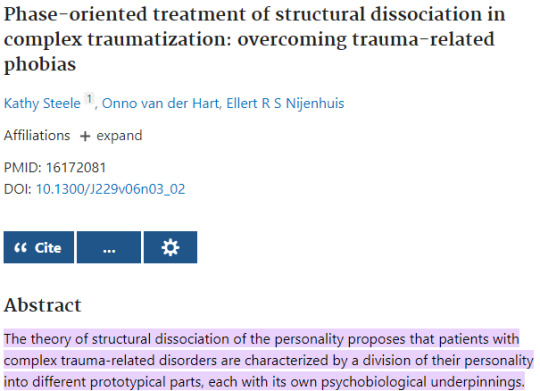
Notice, by the way, that this source never once claims that this is the only way to experience multiple dissociated parts. It only says that this is how they work in trauma-related disorders.
Going back to the new definition of dissociation though and what it actually says.
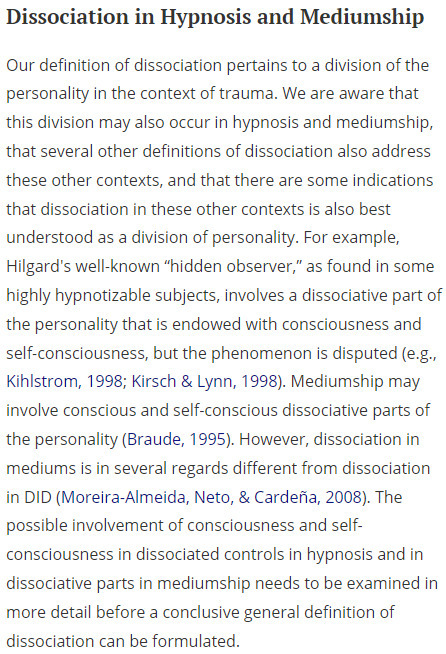
These are the creators of the theory of structural dissociation explicitly saying that there may be other ways for self-conscious dissociative parts of the personality to form.
And this is five years AFTER the article the OP sourced, from the same exact authors.
So the creators of the theory of structural dissociation have said, in essence, that you can possibly be a system without trauma after publishing their theory.
They specialize in trauma, and their theories only apply to dissociation caused by trauma.
Anyone who tries to say these authors are arguing that you can't have dissociative parts without trauma is lying and misrepresenting their views.
And the stupidest thing about this is that it probably wouldn't even matter to the OP
I'm almost certain that if you presented them with this fact, the OP would argue that Ellert R Nijenhuis and Onno van der Hart are super reliable sources when their article happens to be hosted on a .gov domain, but you can't trust those same exact authors when their peer reviewed papers are hosted on a .com domain instead.
That's what happens to your brain when you're focused less on knowing the truth, and more on making up reasons to dismiss the other side out of hand.
#syscourse#pro endogenic#pro endo#systempunk#syspunk#psychiatry#psychology#structural dissociation#dissociation#science#plurality#plural things#endogenic#multiplicity#systems#system#plural system#sysblr#actually plural#actually a system
18 notes
·
View notes
Note
Hi i was just wondering if there are any resources you recommend for writing fics? For names, maps, info about characters and places, anything like that.
I love your blog by the way and your fics are awesome!
Thanks, anon!
I've put together a list of some of my favorite resources that cover the topics you're asking about, with a few extra favorites thrown in. I’ve included both resources that stick purely to canon and worldbuilding resources that expand on canon but are not strictly canon (these are marked with an asterisk). There’s some overlap between some of these resources, but I’ve often found that if I can’t find what I need from one website, another one probably has what I’m looking for.
I’ve broken the resources down into general resources, Silm resources, and LOTR resources for ease of reading. It's a lengthy list, so I've put it below a read more.
And of course, although all of these are good, canon-based resources, it’s always best to verify the information against the source text and double check quotes and citations.
GENERAL RESOURCES
Sources not specific to Silm or LOTR.
Arms and Armour of the Eldar: This webpage lists relevant quotes from Tolkien’s writing about the weapons and armor of the Elves. It predominantly focuses on the First Age but does go into the Third Age.
@askmiddlearth: This blog is a great general reference for all things Tolkien. Although no longer active, the blog has many great guides about the people groups and cultures of Middle-earth, as well as a slew of information accessible from the blog’s tag list about events and time periods, places, races/people/cultures, characters, languages, and objects.
The Atlas of Middle-earth: The Atlas of Middle-earth contains maps of Arda during the First, Second, and Third Ages. There are also maps focusing on the events of The Hobbit and LOTR, as well as thematic maps illustrating the landforms, climate, vegetation and population, and languages of Middle-earth. I have the physical copy of this because I use it all the time and love looking through it just for the sake of looking through it. If you don’t have a copy of this, you can find a lot of Karen Wynn Fonstad’s maps online. @askmiddlearth has shared a number of them on their blog.
Do note, though, the inconsistencies and errors in some of the maps, identified and listed at the Tolkien Gateway link above.
The Dwarrow Scholar*: The Dwarrow Scholar has many resources about Khuzdul and neo-Khuzdul (a fan-created expansion of the language heavily inspired by Semitic languages). The site also has worldbuilding resources covering Dwarven holidays, feasts, seasons, folklore, traditions, marriage customs, succession customs, food, naming conventions, and much more.
Encyclopedia of Arda: The Encyclopedia of Arda has thousands of articles covering topics from Tolkien’s world. It also has a searchable chronicle to discover what happened on a particular date, a calendar to translate dates and events, a glossary of archaic and unusual words in Tolkien’s works, a lexicon of names (mainly in the Elvish languages), and more.
Flora of Middle-earth: I don’t yet own this book, so I can’t personally speak to its usefulness, but it covers all of the plants mentioned or described in Tolkien’s work. It addresses climate zones and plant communities, plant morphology, plant identification, the Two Trees, and the plants of Middle-earth.
Henneth-Annûn Research Center: Henneth-Annûn is a goldmine for quickly finding all of the information given in canon about a character, place, thing, etc. You can search for timeline events, character bios, places, and things, and the site will display all relevant passages from the book that address your search term. There is also an A-Z index of characters, places, things, and events. (There is a full-text Boolean search as well, but at the time of posting this, it doesn’t work.)
LOTR Project: LOTR Project has created timelines and interactive maps for the events of the Silm, The Hobbit, and LOTR. The site has also compiled statistics on the demographics of Arda’s various people groups.
Parf Edhellen*: Parf Edhellen is a dictionary of all of Tolkien’s invented languages, with an emphasis on Elvish languages. Parf Edhellen imports other trusted Tolkien sites’ dictionaries into its own, so it has a vast number of words listed. You can filter your searches by language and time period (when Tolkien created/reworked the language), parts of speech, and the website they were taken from. There are reconstructions (fan-created words formed using Tolkien’s language rules) in the dictionary, but they can be filtered out if you would prefer not to use them.
RealElvish.net*: RealElvish.net provides a slew of resources about Tolkien’s languages (and for more languages than just Sindarin and Quenya), including name lists, phrasebooks, pronunciation guides, and word lists. The site’s Trustworthy Websites page is also worth perusing for links to more sites focusing on Tolkien’s languages.
Tolkien Gateway: Tolkien Gateway is well-known in the fandom as a Tolkien wiki with articles on almost anything you can imagine, but I want to highlight its Silm timeline (covering the days before days, the Years of the Trees, the First Age, and the Second Age), Third Age timeline, and Fourth Age timeline. All of the years listed in the timelines can be clicked on to get a more detailed breakdown of the events that happened that year, which is especially helpful when writing about Third Age events.
SILM RESOURCES
Sources specifically focusing on the First and Second Ages, including Tolkien’s writings beyond the Silm.
@melestasflight's food and cuisine worldbuilding posts*: Melesta’s posts cover both Valinor and Beleriand.
@outofangband's societal and environmental worldbuilding posts*: Outofangband’s societal posts cover people groups in general, fashion, food, education, architecture, festivals, traditions, and more. Their environmental worldbuilding posts cover Beleriand’s flora and fauna, rivers and streams, lakes and springs, forests, marshes, geography, and more.
Silmarillion Writers’ Guild's character biographies: The SWG has an index of character biographies covering many of the characters in the Silm and Tolkien’s other First and Second Age writings. Very useful for a quick refresh about a character or for learning about more obscure characters. (Alternate link to the old site, which lists the characters in alphabetical order.)
LOTR RESOURCES
Sources specifically focused on LOTR and the Third and Fourth Ages.
The Logistics of Minas Tirith*: This short essay by Anders Blixt addresses the logistics of food supply to and distribution within Minas Tirith and poses possible solutions.
Shire of the Hobbits: Shire of the Hobbits has many resources about the Shire, including hobbit customs, typical food and drink, hobbit history, hobbit names and meanings, and a list of hobbit sayings. The site also has information about hobbit calendars and chronology, the various writings produced in the Shire, and the Shire’s geography.
The Religious Rituals of the Dúnedain of Gondor*: This essay by Michael R. Hickman explores canon information about the Dúnedain’s religious customs and ceremonies and uses that information to expand on how those religious customs and ceremonies might look in Fourth Age Gondor under Aragorn’s rule. I haven’t yet read all of the way through the essay, but it is well-cited, using an array of Tolkien’s texts on the subject.
Travel Times in Middle-earth*: This site has generic info about how long it would take to travel in Middle-earth (focusing on major Third Age locations), based on the mode of travel. There is also a table that lists the time it would take to travel from one location to another. The table is incomplete but still very helpful.
#lotr#the silmarillion#you could say i like researching lol#let me know if you're looking for anything more specific anon!#asks#anonymous#.txt#reference
74 notes
·
View notes
Text
writing an A+ essay for the humanities courses by your TA, step by step:
First step is always to read your guidelines very carefully and take note of the format; this means the word limit, referencing style (MLA, APA, Chicago, Harvard), and spacing. Write down the steps your professor expects (announcing your topic, first draft, meeting etc.) and their due dates.
finding your topic
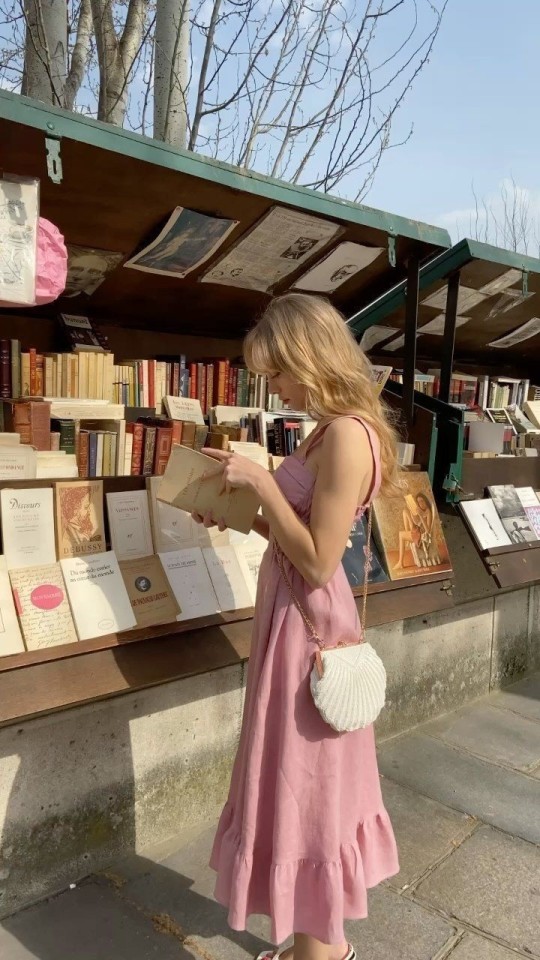

🎀 start with your syllabus, is there any topic that you'd like to delve in to more? something that catches your attention? is there anything in your notes that you'd like to explore?
🎀 alternatively, you can take a look at your reading list and take note of journals that the articles were published in. you can write down some of the journal names and read through their latest publications through your library access for inspiration.
🎀 after you have a general idea of what you'd like to research, do an initial web search, a jstor search, and a library search. skim through the abstracts and selectively read what looks interesting to have an idea on this area of study and note down the kind of questions they try to answer in these papers.
🎀 book an appointment with your professor. chances are you're already required to let them know what you'll be writing on before you hand the paper in. so go to their office hours and tell them this is what you'd like to research, even if you're kind of scared or anxious or nervous, go and talk to them. they'll ask you some questions about how you'd like to go around researching your topic, and you can tell them about the kind of questions you found that could be interesting to pursue. they can advise you on how to narrow your topic down or point you towards some useful material. with that, you can start researching!
how to research


📚 while there is no one-size-fits-all research method, something helpful to do is picking out books on the topic and going through the bibliography. don't try to read everything ever written on this topic, but look at the abstracts and key words and skim through papers & books to find things relevant to your topic.
📚 definitely look into your professor's recommendations and you can jump from there, just bibliography hop and note down page numbers and citations on your word page that you'd like to use.
📚 as you read and note quotes, after some point you'll see a pattern and a shape of an argument forming in your head. arrange your quotes into logical sections that follow that argument and read a bit more to see if you can specifically find things written about that argument you've discovered. continue noting quotes.
📚 remember that for an undergrad paper, your professor will advise you on how many references you should ideally have in your paper and you should follow that. in your quotes stage, try to shoot a little bit higher than the advised number of bibliography you're expected to have. always, ALWAYS write your citations correctly with page numbers, even if you've paraphrased their arguments for your notes.
writing your paper


🩷 now, at some point you'll need to slow down on reading and start writing. you have some writing on your word page already, and chances are, you're already sitting with an over-the-word-limit paper just containing quotes. this is ideal.
✨️ start with trying to articulate your argument, and summarising the thread you've built with quotes. what is it that you're trying to answer here? how does it relate to your material (your primary source, this could be a literary book, an archaeological evidence, a building, an object, a painting, etc)?
🩷 do a little sectioning with your quotes, label 2 or 3 sections and group the quotes this way. then, write down what this group does, what do they argue for, what is the context of this argument, and how it relates to your argument.
✨️ go through all your sections like this. you can strike down some quotes, or choose to paraphrase them (you still need to cite them when you do this). try to use quotes that communicate with each other, or build a bridge between your different quotes. Add two more sections labeled: introduction, conclusion.
🩷 in the introduction you should give a brief context of your primary, verrrry brief, and then your argument that is stated as clearly as possible. you can give a short path as to how you're going to argue and what kind of proof you have; and also write down how you've organised your paper.
✨️ in the conclusion you summarise your argument and write down the implications of this in the general context of this area of study; what does it mean for this topic in general, what impact does it have, does your argument fill a gap, does it contradict the general consensus, does it prove that the general view is correct? you could write down what could be further studied for extra flair.
editing
🪸 check your citations, references, and bibliography. check them again. are they in the correct format? do they include all the information you need to provide? is it alphabetical? have you correctly gave references everywhere you needed to do and did not accidentally plagiarise anything?
🪸 check your spelling and grammar. try to do this about three days after you've written the paper. if you're pressed for time, have someone else read it for you. you will not be able to catch your grammatical errors after writing it because you become blind to your own writing after a certain time. if you want that A, the paper should look polished and have the correct formatting.
🪸 make sure your name is on the paper so you'll see it marked with an A+. Well done!
17 notes
·
View notes
Text
How to Conduct a Literature Review Using Digital Tools (with Notion Template)
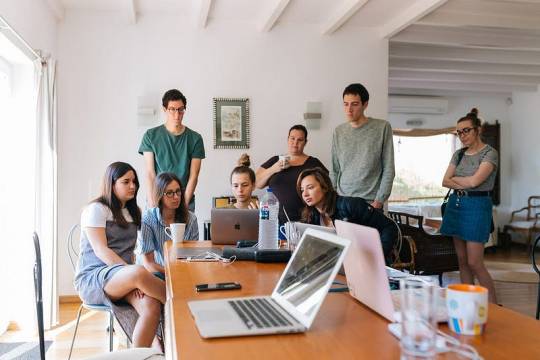
Embarking on a literature review is a fundamental component of academic research that can often appear overwhelming due to the sheer volume of relevant articles and sources. However, leveraging digital tools like Notion can substantially streamline and enhance this process. By providing a structured approach, Notion enables researchers to manage their literature reviews with greater efficiency and organization. This comprehensive guide will walk you through a methodical literature review workflow using Notion, explore various digital tools, and offer a Notion template to facilitate your research.
The Benefits of Using Notion

Notion is an advanced organizational tool that integrates the functionalities of note-taking, project management, and database creation into a single platform. Its versatility is particularly advantageous for managing a literature review. Here are several key benefits of using Notion:
Integration of Pages and Databases: Notion allows for seamless linking of pages and embedding of databases within other pages. This interconnected structure facilitates comprehensive data management and easy navigation between related information.
Customizable Filters and Sorting: Users can create custom properties and apply filters to databases, which enables sophisticated sorting and retrieval of data tailored to specific research needs.
Efficient Data Management: Notion supports the transfer and management of data from Excel sheets, enhancing the organization and accessibility of research materials.
In my workflow, Notion plays a central role through two primary databases: the ‘literature tracker’ and the ‘literature notes’ matrix. These databases are instrumental in tracking papers and synthesizing information to construct a coherent argument.
Stages to Literature Review Workflow

1. The Literature Search
The initial phase of a literature review involves a systematic search for relevant sources. This step is critical for building a comprehensive and well-rounded review.
Identify Keywords: Begin by developing a list of keywords that are pertinent to your research questions. Engage with your supervisor or colleagues to refine this list, ensuring it encompasses all relevant terms. As you progress, be prepared to adjust your keywords based on emerging research trends and findings.
Utilize Database Search Tools: Employ established databases such as Web of Science, Scopus, Google Scholar to locate pertinent literature. These platforms offer extensive search functionalities and access to a broad range of academic papers. Additionally, set up email alerts for new publications related to your keywords. This proactive approach ensures that you remain informed about the latest developments in your field.
Library Building and Recommendations: Manage your literature library using tools like Mendeley, which facilitates the organization of references and offers recommendations for related papers. Mendeley’s sharing capabilities also enable collaboration with colleagues, enhancing the collective management of research resources.
2. Literature Mapping Tools

Literature mapping tools are invaluable for visualizing the relationships between papers and identifying key research themes.
Citation Gecko: This tool constructs a citation tree from ‘seed papers,’ illustrating the connections between various studies through their citation relationships. It is particularly useful for uncovering seminal works and understanding the progression of research topics.
Connected Papers: Connected Papers uses a similarity algorithm to generate a graph of related papers based on a given key paper. This tool provides insights into related research that may not be immediately evident through direct citation links, helping to broaden your understanding of the field.
3. The Literature Tracker
An organized literature tracker is essential for managing and reviewing research papers effectively.
Organize with Notion: Utilize Notion’s customizable properties to document essential details of each paper. This includes metadata such as title, author, publication date, keywords, and summary. The ability to filter and sort this data simplifies the process of managing large volumes of literature.
Database Views: Notion offers various database views, such as the kanban board, which can be used to track your reading workflow. This visual representation aids in monitoring your progress and managing tasks associated with your literature review.
4. The Literature Synthesis Matrix
The synthesis matrix is a crucial component for organizing and synthesizing information from the literature.
Second Pass of Papers: After an initial screening, populate the ‘literature notes’ database with detailed information from the papers you deem relevant. This should include comprehensive notes on the paper’s summary, key results, methodology, critiques, and any future work suggested.
Relational Databases: Leverage Notion’s relational database capabilities to link related papers and create a synthesis matrix. This matrix helps in identifying connections between different studies and assists in constructing a coherent narrative for your literature review.
5. Writing Your Literature Review

Writing a literature review involves synthesizing the collected information into a structured and insightful analysis.
Identify Research Themes: Use your literature matrix to pinpoint key research themes and questions. These themes will form the basis of your literature review sections and guide the development of your thesis statement(s).
Summarize and Evaluate Sources: Focus on the most significant sources for each theme, summarizing their key points and critically evaluating their contributions. This involves assessing the strengths and weaknesses of each study and linking related research to provide a comprehensive overview.
Situate Your Research: Clearly articulate the research gap your study addresses, justifying your research approach based on the identified gaps and the synthesis of the reviewed literature.
6. Iterating Your Literature Review
A literature review is a dynamic process that requires regular updates and revisions.
Regular Updates: Continuously update your literature review as new research emerges. Balance the time spent on reading with the progress of your own research to ensure that your review remains current and relevant.
Notion Template
To facilitate your literature review process, I have developed a Notion template that includes:
A Literature Tracker Database: For recording and managing details of relevant papers.
A Literature Notes Database: For detailed notes and synthesis of the literature.
Predefined Properties: For filtering and sorting entries according to specific research needs.
You can duplicate and customize this template to fit your research requirements.
Useful Resources
Here are some additional resources that can aid in the literature review process:
The Literature Review: Step-by-Step Guide for Students
3 Steps to Save You From Drowning in Your Literature Review
How to Write a Literature Review
How to Become a Literature Searching Ninja
Mind the Gap
7 Secrets to Write a PhD Literature Review The Right Way
By following this structured approach and utilizing digital tools like Notion, you can streamline your literature review process, enhance organization, and ensure that your research is thorough and well-founded. This methodology not only simplifies the review process but also provides a robust framework for developing a strong thesis or dissertation.
Investing in your academic future with Dissertation Writing Help For Students means choosing a dedicated professional who understands the complexities of dissertation writing and is committed to your success. With a comprehensive range of services, personalized attention, and a proven track record of helping students achieve their academic goals, I am here to support you at every stage of your dissertation journey.
Feel free to reach out to me at [email protected] to commence a collaborative endeavor towards scholarly excellence. Whether you seek guidance in crafting a compelling research proposal, require comprehensive editing to refine your dissertation, or need support in conducting a thorough literature review, I am here to facilitate your journey towards academic success. and discuss how I can assist you in realizing your academic aspirations.
#gradblr#academics#education#grad school#phd#phd life#phd research#phd student#phdblr#study#studyspo#students#studyblr#studying#student#study motivation#study blog#university student#uniblr#university#dissertation help#dissertation writing#dissertation abstract#dissertation topics#phdjourney#graduate school#thesis writing#thesis help#thesis tag#thesis statement
5 notes
·
View notes
Note
Do you think Eddie was flagging in the show?
If this approaches discourse, I'll understand if you choose not to respond.
This is kind of a multi-layered question, but I think it’s worth talking about in the context of broader approaches to fandom.
I haven’t seen these terms used for a while, but fans used to talk about “Watsonian” and “Doylist” explanations as a good shorthand for ���in-universe logic/rationale” and “out-of-universe motivations.” For example, the Watsonian (as in what John Watson might think) explanation for a villain monologue might be that the character wanted to prolong his moment of victory because he wasn’t ready to let the feud go. The Doylist (as in what Arthur Conan Doyle might think) explanation might be that the author needed to pad out the wordcount.
The important part is that neither of those lenses is wrong. They’re just different ways of looking at a text.
Word of God (i.e. what the creators say about a work in interviews etc.) is not the same as canon, and canon is not sacred. It’s just what’s on the screen or page.
I’m going to be a little self-indulgent here and bring in some Death of the Author by Roland Barthes, because I literally have a page of quotes stored on my tumblr. Admittedly, the translation I have is a little dense, but I think I’ve pulled out the key points. (Also, caveat that this is not the only valid way to do lit crit, but I think it can be very helpful in fandom.)
“The text is a tissue of citations, resulting from the thousand sources of culture.”
I think about this all the time in regard to fandom, because it reminds me that texts don’t spring fully-formed from some ethereal plane. The cultural and literary references you grew up with, as well as the ones you continue to consume, feed directly into whatever you produce as a creator. That’s why my number one tip for young creatives who want to improve is to be intentional about the media they consume*. That’s where inspiration comes from: just tip more material into the slurry of your subconscious, and see what alchemized new thing bubbles to the surface.
That also means that as critical readers, we can always try to see connections and patterns, regardless of Word of God. However, it’s important to remember that those connections and patterns are not necessarily lodged within the text itself…and that brings me to my next quote.
“The unity of a text is not in its origin, it is in its destination.”
It’s rarely useful or interesting, in the context of fandom, to treat a text as an artifact to be excavated. It’s much more relevant and functional to ask what you as an individual get from the text—what your own relationship is to the themes, motifs, ideas, messages you’ve gleaned from your experience of reading/watching. Every reader has a different relationship to the text, because every reader is a different person with a different history.
The difference between fandom and Extended Universe-type stuff isn’t just licensing. Frankly, I personally would find that a pretty boring fandom experience, if absolutely everything were strictly canon-compliant and cross-referenced. Fandom is transformative, which means it interprets and reinterprets texts as a form of consumption/creation, and that necessarily means a willingness to discard anything that doesn’t suit whatever story we’re trying to tell.
In other words, Eddie doesn’t have a canon sexuality. Hell, very few characters in general do. As I mentioned in the first footnote to my last reply, it’s useful to think about sexuality as behavior + identity + desire; we often see behavior on screen, but we rarely see the other two in an explicit way. We can read him as flirting with Steve, we can read him as flirting with Chrissy, or both, or neither. That’s how fandom works.
So, do I think Eddie was flagging in the show?
Let’s break that question down into a few different aspects.
Doylist: do I personally believe that the various people involved in the show deliberately intended Eddie to flag as a(n implicitly MSM) sado top?
No. I don’t. Honestly, I simply don’t trust them that much. I don’t think they had queerness explicitly in mind when they created Eddie, but that doesn’t change the fact that he is queer-coded, much like a Disney villain. He represents anxieties about nonconformity and morality—of course he’s going to resonate with queer people.
Ultimately, though, I don't really care about this particular creative team's intent. It's not interesting to me. There are so many shows that I enjoy more than ST for their artistic choices, and I'm interested in hearing the intent behind those, but specifically what I personally enjoy about ST is the stories its components let other people tell.
Watsonian (1): do I personally believe it’s within Eddie’s canon characterization to be flagging?
It’s not impossible. It’s also not impossible that he’s just aping more generic metal accessories. Personally, I think it’s somewhat unlikely that at 19-20, living in the middle of nowhere and with the various plates he’s spinning, Eddie’s had enough exposure to kink to be really confident and knowledgeable about flagging. But I’ve also heard some pretty wild stories about small town gays back in the day, so I’m willing to be convinced either way.
Watsonian (2): do I personally believe it’s within Eddie’s canon characterization to be a sado top?
This is venturing into some even trickier waters, but my answer’s very similar to the last question—it’s not impossible. You don’t need to be a particular kind of person to be a top/bottom/dom/sub, no matter what the old fandom flamewars may have claimed. (Being in my early teens and witnessing the SasuNaru vs NaruSasu discourse was not a good way to learn about this.) Different parts of the same experience can resonate with people for different reasons, and there’s more than enough wiggle room to interpret literally any character in any way.
(I will say that people who actively seek out DMing tend to enjoy controlling a scene to evoke particular emotional responses from players, and that's the angle I find most plausible for Eddie.)
I am personally agnostic on the matter of Eddie’s sexual preferences. As a reader, it’s most important to me that those preferences are coherent with the rest of the characterization within the fic. As a writer, I tend to characterize him as pretty switchy for the same reason I tend to characterize him as gay and into mythology: I am just projecting onto a blorbo.
That’s all any of this really is.
*On a practical level: I often suggest to young creatives that they make a habit of identifying at least one thing they like AND at least one thing they don’t like about art, whatever form that art comes in. It builds critical faculties by making sure you actually digest the art you're consuming, and it’s also a good reminder that even the worst piece of dreck (probably) has something worth learning from—and even the most sublime masterpiece has flaws.
#askbox#WHY NOT witter on for 1k words about a knot of hot-button issues for my 100th post. why not. christ.#overusing the word 'personally' to emphasize that IT'S ALL SUBJECTIVE art is fake critique is fake live ur life#I'm just...the kind of insufferable person who has a color-coded spreadsheet rating all the musicals and plays I see#again: I will delete & block at the first sign of discourse! can u tell I have like. tumblr trauma from 2013#ST meta for TS
73 notes
·
View notes
Text
Thesis Writing Process
The 5-Step Process for Writing a Thesis: A Super Comprehensive Guide
Writing a thesis is a glorious academic moment in which perhaps the cumulative outcome of four years of study and research is being produced. While intimidating as a thought, however, it breaks down into pragmatic steps that ensure clarity and efficiency, and a polished final product. This blog publishes a comprehensive guide on a 5-step process to guide you through your thesis journey.
Step 1: Select and Refine Your Research Topic One first step in writing a dissertation is to select a topic of interest to you, relevant to your academic interest, career objectives, and the study area. Write down general ideas that interest you as well as are applicable to your field of study. Begin preliminary research into your selected ideas.
Narrow the Focus: A narrow, well-defined research question is easier to manage and is more meaningful than an open-ended one. It can be related that a broad topic like "Climate Change" is better narrowed down to be, "The Effects of Renewable Policies towards Reducing Carbon Emissions in Urban Areas."
Step 2: Do a Thorough Research
Having a topic in mind, proceed with research. Research is essentially collecting and synthesizing information that will lead to an excellent grounding for your thesis.
Primary vs. Secondary Sources: Mix primary sources, like experiments, surveys, or interviews, with secondary ones, like journal articles, books, or reports.
Take Notes: Use Zotero or End with the collection of references and systematic notes.
Critical Evaluation: Examine your sources critically to determine if they relate to and support your thesis question and are appropriate to your topic. Maintain a journal of interesting ideas, major findings, and citations as you conduct research. This will facilitate the writing process later on. --- ### Step 3: Thoroughly Give It a Good Framework A good thesis is also well-structured. Before you begin writing, draft a rough outline of your work to ensure it will be orderly.
Introduction: State your research question, objectives and the reasons why your study holds its importance. \
Literature Review: Summarize and critique previous studies to pinpoint what is unique in your study. \
Methodology: Discuss the methods and tools that you used to carry on your research. \
Results and Discussion: Present your findings, analyze them and relate to your research question. Conclusion: Summarize major findings and say what they imply, and indicate future avenues for research.
This road-map achieves proper flow and coherence for both the writer and the reader.
Core Sections First: Prepare methodology, results and discussion first because such parts are often the core sections of your thesis.
Be Clear; Be Concise: Avoid using jargons unless unavoidable and define technical terms to reach more audiences.
Get Feedback: Share drafts with your advisor or peers in order to get constructive feedback.
Edit Ruthlessly: Review for clarity, grammar, and coherence. Tools like Grammarly and Hemingway Editor can help polish your writing.
Set daily or weekly writing goals to maintain steady progress.
Step 5: Finalize and Defend
Prepare your thesis for submission and defense.
Formatting and Citation: Format according to your institution's guidelines on the formatting, citation, and referencing. Double-check everything for consistency.
Proofread: Read through the document at least three or four times for spotting typos, inconsistencies in formatting, or other mistakes. You might consider hiring a professional proofreader to help you out.
Practice Presentation and Q&A: Rehearse your presentation a number of times. Think about questions that may be presented to you by the panel. Be prepared to back up your statements with evidence and speak assertively regarding the research.
The day you defend your dissertation is the day to celebrate all the hard work and achievement made until then. . Conclusion Writing a thesis is quite demanding but highly rewarding for it tests your critical thinking abilities, researching, and the skill to write. If you break down these steps to the choosing of the topic, research, structuring, writing, and finalizing, you'll be in a better position in handling the entire process. Remember that persistence and careful planning will get a thesis written that will not only demonstrate one's knowledge of the subject matter but also contribute to the field.
In fact, it takes a lot of courage to move on with this project, and these steps shall take you to it!
Need expert guidance for your PhD, Master’s thesis, or research writing journey? Click the link below to access resources and support tailored to help you excel every step of the way. Unlock your full research potential today!

Follow us on Instagram: https://www.instagram.com/writebing/
#thesis#phd student#exams#phd life#dissertation#phdjourney#phd research#university#grad school#writingcitation
2 notes
·
View notes
Note
Do you believe in doing outlines in academic writing? If so, do you have any hot tips?
Jesus Christ, yes, please, please make outlines for your academic writing, at least if it's a paper of any decent length (i.e. 20 pages or more) or covers a topic in any complexity or detail. If it's just a 5- or 6-page undergraduate paper, you don't need to, but if you're writing a senior thesis, master's thesis, PhD dissertation, journal article, or anything else that represents a significant effort and unfolds in multiple parts, then you will absolutely need to outline it.
First: establish the main chapters or sections of your paper, sub-sections or main topics within each section, and what order makes the most sense for the content to go in. For example, if you're writing about the US Civil War, you can't leap right into the major battles or the aftermath/Lincoln's assassination/Reconstruction if you don't first establish the historical background and major events leading up to it. It might also be worth listing the sources that you expect to be most useful in each section.
Second: since, as exemplified by the Great Citation Debacle of 2022, both myself and pretty much every single academic in existence have strong opinions on citation, reference, and bibliography systems, it is worth drawing up a rough draft/working bibliography as part of your outlining process. You can organize your sources topically, thematically, chronologically, etc., but make sure you have all the information that will be required for a bibliography entry, as this will save you many headaches, and double-check which citation method you will be using. Download style sheets if necessary.
Third: once you have hammered out the rough order of your paper as noted in step one, you can refine the arrangement of sections, add more sub-topics, or other important content that you will need to cover. You can use different text colors if it helps you to visually differentiate which parts go where. Your paper will generally go something like:
Introduction (Opening, State of the Field, Thesis Statement, Literature Review, Formulation of the Problem, Proposed Answer, Outline of Contents, Expected Conclusion)
Chapter One (Chapter Intro -- Main Section 1, Subsections 1, 2, 3 -- Main Section 2, Subsections 1, 2, 3 -- Main Section 3, Subsection 1, Sub-subsections a, b, c, Subsections 2, 3 -- Chapter Conclusion)
Etc etc for other chapters/sections;
Conclusion (Recap of Methods and Sources, Repeat of Thesis Statement, Answer of Problem, Explanation of Results, Implications for Future Research)
Bibliography
Your references/notes may be incorporated into the body of the paper or placed at the end, but that's an overall pretty basic and foolproof way to start drawing up what you will need to do. Working with the material beforehand, especially identifying your most relevant sources and topic arrangement, will allow you to be more familiar and fluent with what you need when it comes time to do the actual writing.
64 notes
·
View notes
Text
Strategies for Conducting Effective Research for Essays: Finding Reliable Sources.
In the realm of academic essay writing, one of the foundational pillars of constructing a compelling argument is the utilization of reliable sources. The credibility of your research materials directly impacts the persuasiveness and authority of your essay. In this essay, we will explore a set of strategies designed to help researchers identify and utilize trustworthy sources effectively.
Academic Databases: Begin your research journey by delving into reputable academic databases such as JSTOR, PubMed, Google Scholar, and your institution's library resources. These platforms host a treasure trove of peer-reviewed articles and research papers that form the bedrock of reliable information.
Library Resources: Do not underestimate the enduring value of brick-and-mortar libraries. Skilled librarians can provide invaluable assistance in uncovering relevant books, journals, and physical resources tailored to your essay's subject matter.
Citation Tracking: A lesser-known but potent technique is citation tracking. When you locate a pertinent source, explore its references and citations. This method can unveil additional reliable sources that share thematic connections with your research.
Government and NGO Websites: Government websites, such as the CDC and NIH, alongside respected non-governmental organizations, often offer trustworthy statistics and research reports. These sources are particularly valuable for essays that require data-driven insights.
Critical Evaluation: One of the most crucial skills in research is the ability to critically evaluate sources. Scrutinize the author's qualifications, publication date, publisher, and potential biases. Scholarly journals and books generally exhibit higher levels of reliability compared to personal blogs or unverified websites.
In conclusion, the process of sourcing reliable information for your essays is a critical aspect of academic research and writing. Employing these strategies - from exploring academic databases to critically evaluating sources - will fortify the foundation of your research and elevate the quality of your essays. By cultivating the art of discernment, you empower yourself as a researcher to craft essays that are not only informative but also persuasive and credible, enriching the academic discourse in your chosen field of study.



#college life#student#study#studying#university#student life#college#study space#study hard#exam stress#study blog#study motivation#fypツ#essay writing#studyinspo
14 notes
·
View notes
Text




𝔏ite 𝔏ore! the links below should apprise you of the intricate references, research, and definitions of ourolite's original characters. any queries or urgent messages may be directed to our ask box; we might inadvertently miss comment notifications or get to them a lil' late, so try this instead!
prelude: mentions all characters. may include homes, occupations, family, a few notable non-main characters, potential backstories or general history and possibly relationship notes, notable hobby info, race + ethnicity information (culture, languages, etc), relevant locales, pets, neighbors, ourolite original mythical creations, and canon events. many/most links are via Google docs, so please download the Google docs app for the best possible display and remain with a dark mode setting as you explore. if you're unable to do so at this time, no worries, but we do apologize for the iffy presentation! thanks for clicking, enjoy.

♡ INDIGO ( maneki-neko! oc ) spider-kitty: spider-man au. abodes: various au’s. antecedents.
♥︎ ILLŪNIS ( rusalka! oc ) antisocial personality disorder research. deaf research. anomaly: spider-man au. cornus lamya: selenic shrine. abodes: various au’s. antecedents.
♥︎ FRANKINCENSE ( churel mother! oc ) schizophrenia research. dominican culture research. ___: modern occupation. abodes: various au’s antecedents.
♡ YASHMI-NOIR ( angel daughter! oc ) relationship with cookies. tree house. antecedents.
♥︎ XĪN’YUÈ ÀN ZHŌNG ( billionaire ceo! oc ) ànzhōng: universal business. maju + blumei: puppy daughters. abodes: various au’s. antecedents.
♥︎ CIRCE YUÈ'LI ( vampire! oc ) yìzé and babydoll: pet dogs. chinese and senegalese culture research. abodes: various au’s. antecedents.
♡ JIHANE MEILĖ ( metaphysician djinn! oc ) ___: universal shop. abodes: various au’s. antecedents.
♥︎ J'ŪLILI ANÉO LĀPAKI ( plutonian bunny! oc ) sao glace: selenic shrine. modern occupation(s). maxixe: pet polar bear cub. abodes: various au’s. antecedents.
♡ YÚYĪN ÀN ZHŌNG ( emhalo xipe’va! oc ) anomaly: spider-man au. xipe’va: mythical race (leman originated). abodes: various au’s. antecedents.
♡ MÉLIOR VILLOSA ( amoisa xipe’va! oc ) kpop idol career: modern. tea: multiple personalities. xipe’va: mythical race (leman originated). abodes: various au’s. antecedents.
♡ MAKA GALILHAI ( autistic swordsman! oc ) anomaly star-spider: spider-man au. japanese culture research. autism research. abodes: various au’s. antecedents.
♥︎ EUN BYEOL ( mute neptunian! oc ) selective mutism research. selenians: mythical race (neso originated). abodes: various au’s. antecedents.
♥︎ ZOLENE IRENE ( demi-god! oc ) attention deficient hyperactivity disorder research. sun-spider: spider-man au. ___: food truck. ___: family restaurant. abodes: various au’s. antecedents.
♥︎ TIDA-BITUIN MIYAGI ( blind prodigy! oc ) okinawan japanese research. blindness research + prodigy citations. abodes: various au’s. antecedents.

⑅ leman productions. all rights fucking reserved, do not plagiarize.
#oc#oc masterlist#oc maker#oc prompt#oc posting#ocs#oc lore#my ocs#oc original character#oc masterpost#oc lineup#original character#original character oc#male oc#female oc#monster x reader#monster x human#monster oc#mythical creatures#mythical oc#oc stuff#oc x oc#oc x reader#original character x reader#original character x canon character#oc x character#oc x canon#black owned#black oc#black original character
6 notes
·
View notes
Note
Γεια σου! I’m a Romanian History student specialising in International Relations and I am about to enter the last year of my Bachelor’s Degree, meaning I will have to write a thesis in order to obtain a diploma. I also happen to be learning Greek. I have been fascinated by the history of 20th century Greece for a while now and have written almost every essay we were assigned on topics surrounding it, thus I have picked “Greece’s foreign policy in the 20th century” as the topic for my thesis. As for any other scholarly work, I will be in need of primary sources and I was wondering if there are any Greek digitalised archives which may contain relevant documents regarding Greece’s foreign affairs and so on? Thank you so much!
Γεια! Bună! :)
I don't know if I can come up with sources for exactly what you ask in specific but here's some stuff I found.
I would first recommend the captain obvious / sly way: Go to the page of the History of Modern Greece in Wikipedia. The page is very detailed and long and it links you to even more detailed main articles about all the historical events one by one. And there are all the references you can search more and the citations you can use there. I linked the English page - but do study the Greek equivalent simultaneously. Sometimes the English one leans towards British / French "inherent innocence" in regards to its involvement in Greek matters. So both together, with their links to extra pages and all the references can provide a generous amount of information that will be pretty safe.
Old publications released by the Ministry of Foreign Affairs. They cover several of the years 1878 - 1921. Half are in Greek and half are in French though. Here's the link.
Here you will find the pdf of the standard senior high school book on modern and modern Greek history.
This is a pdf of the Topics on Modern Greek History, the schoolbook of the senior year in high school for those who plan to study humanities and social sciences in particular.
The link I am giving you below includes online catalogs from Greek libraries (National Library, Academy of Athens and Gennadius Library). It also has links to open access databases on Modern Greek studies. It's catalogs though, research guides. Not access to the books themselves.
One that might be useful is the Journal of Modern Greek Studies. It's the scientific journal dealing with Greek history and culture exclusively after the Byzantine era.
I would recommend the podcast of historian Giorgos Mavrogordatos - Διορθωτικά Μαθήματα Ιστορίας (Corrective History Lessons). It's very serious work, based on his books as well which he mentions so you can search for them and buy them for more info or in order to cite them. You will find his podcast everywhere, Apple, Spotify, and pod.gr . It has around 67 episodes I believe, the first nine discuss other incidents in Europe and the world which could be similar to Greece's situation and then all the rest are about Greece - mostly the events of 1922 but stretching before and after that, and then some episodes about the Greek monarchy. Of course the problem is that it is, well, a podcast, therefore you need to be acquainted with listening to Greek rather than reading it.
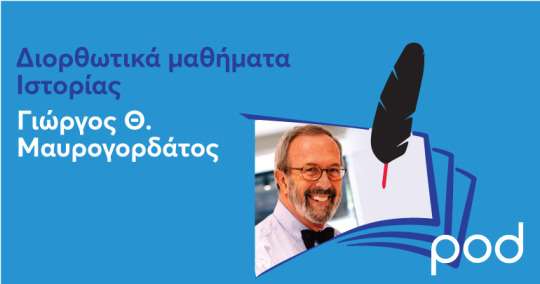
A history website that has great quality and a lot of stuff is Η ΜΗΧΑΝΗ ΤΟΥ ΧΡΟΝΟΥ. It has also articles about world history and its own podcasts. It has a huge archive of articles on Greek history and particularly the modern one, and a lot of little known events, people's documentations and experiences of said historical events, which can give a touch of spice to your thesis. Check out its history menu in this screenshot:
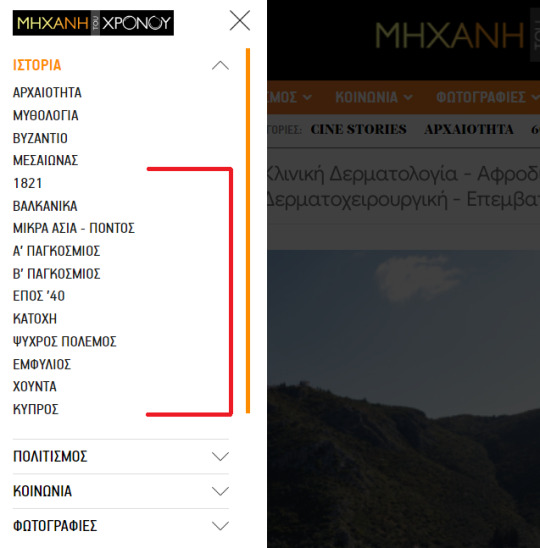
See, it covers the 20th century exhaustively. Of course, it's a website, so what you can do is that once you read something useful in this website, you then make a targeted search about it on the Internet to find the scientific sources and citations because they don't do it themselves often. But they are legit.
That's the best I could do. Inviting anyone knowing history professors' by name to give us links to their publications (cos I am bad with names and remembering sources and such) or if there is any digital archive database you know out there, help Anon out!!!
In the meantime, I still think the wikipedia can save a life when used carefully. And the podcast is good. In fact, if you search your pod app with Greek characters about "νεότερη Ελληνική ιστορία", it might give you several useful results.
BTW I was amazed to find out that we apparently do not have a Greek-based proper, modern, attractive, friendly to use website about Greek History (all of it), addressed to everyone interested and just being a good, extensive and easily accessible source of historiographical content. I have seen many other nations, even much smaller, having such and putting a lot of work in them (although to my recollection in some cases the contents are wild and not very scientific...). You'd expect Greece would have something similar (hopefully minus the unscientific part) about Greek history but nah. This is both sad and not surprising at all. I mean, η μηχανή του χρόνου is good but it's mostly Greek for Greeks. And other blogs that are very personal and subjective may lack in integrity. But an official modern state-supported website that could engage people from all over the world? Nah. I mean, the ministry itself suggests in the year of our Lord 2023 to use IE4 as a browser! Put THAT on your thesis Anon *laughs to hide the frustration*
#greece#greek history#history#modern greek history#resources#i mean...meh#i hope buna is correct btw#anon#ask#tw long post#tw long text#tw long#coals of greece
11 notes
·
View notes
Text
On Liechtenauer, Martial Arts, and a specific definition of winning.
To love for a lifetime is to fall in and out of infatuation. To see faults and determine to continue to put in the effort. It is to find yourself exasperated by the flaws in the place your affection is vested, only to come around again and remember where that love grew from to begin with. This essay is going to be about HEMA generally, about Kunst des Fechtens specifically, and about old books and why I don’t think anything passed down can belong to you.
This essay is going to be a series of disjointed thoughts that may or may not tie together at the end. There will be no citations, no references to specific pieces of text to prove a point. I’m not going to back anything up with data, and I’m not going to point to a specific part of something written and say “this is proof of what I mean.” This is no more and less than one person’s opinion, based purely on feelings and experience and anecdotes, for whatever that’s worth to the reader.
I have three books in my office that are over one hundred years old. Of these, one is a copy of Meditations by Marcus Aurelius. It does not actually belong to me, but it was loaned by a friend who moved out of state before I could give it back. It is beautiful and thought provoking, but—and this will be relevant later—it does not actually belong to me. It’s on-loan, even if that loan is extended. The second of these books is a copy of the collected poetry of Sir Walter Scott. I have not read it, mostly because I am afraid that it will fall apart if I flip too thoughtlessly through its pages. I found it at an antique store ten years ago, and I did not realize how precious it was until I got home, where I discovered a letter from a father to his daughter written in the early 1900’s, and a perfectly preserved rose pressed between the pages. I do not want to damage either, so I keep them where I found them. They are in my keeping, but like the first book, they do not feel like mine.
The third book is a copy of the Rubaiyat of Omar Khayyam. I had a weird introduction to this book, which I have also read many times. When I was seventeen I was standing in a grocery aisle in Oregon, looking at beer that I couldn’t legally drink yet. Out of the blue, an old man I had never met approached me and started quoting from the poems. I don’t remember exactly what stanza—I think it was one of the ones warning people about drinking too much—but it stuck in my head and over the years I have acquired multiple copies, though none are as rare as this one. Even though I found it in a box of old books a friend had in their trunk, this one, like all the others, feels like a gift that I need to safeguard, until someday I give it to someone else.
I do not think that old things truly belong to us. Especially not those that have been passed down, and I think that treating them like possessions to be altered or discarded at will is a very consumerist way of thinking about things that should have more value. Especially when those things were created with blood, sweat, and tears, and when their existence was paid for in lives. Even if those lives were ended a long time ago. Even with treasured family heirlooms or old things that we stumble across, we are far more transient than they are, and at most we only keep them for a little while.
I started studying HEMA in 2008 with Fiore, and I transitioned to training Kunst des Fechtens exclusively in 2015. Liechtenauer’s art occupies a strange space, as far as Martial Arts go. Like the majority of earlier HEMA sources, it does not possess a living lineage of teacher-to-student transmission. What we have as practitioners is a series of texts expressing common principles and techniques, with only hints and bits of secondary and primary sources that offer suggestions as to the traditions that surrounded these arts when they were living. Because we are working to recreate this art from what has been left to us, it is easy to imagine that what we are creating is wholly new and our own, and that we have the right to make it our own. It is a common sentiment in many modern martial arts that the goal of training is to create a fighter whose deepest skill is expressed by the number of wins in competition and freeplay, however that’s defined. A not uncommon line of thought in many HEMA circles, including ones to which I am very close, is that creating great fencers, great fighters, is the primary purpose of our study. In some cases the only purpose.
I don’t really think that way. I used to, or at least I used to think that I should, but I don’t anymore.
What distinguishes Liechtenauer from other sources for me is the same thing that changed how I look at HEMA and functionally at Martial Arts in general. More than a set of techniques, more than the Five Words or the Haupstuck themselves, it is a system that teaches understanding of its subject material in a very layered way. I know consensus on this isn’t settled, but it’s always been my impression that the Zettel and several of the glosses are laid out in deliberate manner where techniques are unpacked in order to express the principles that they are trying to teach. Each section goes on to break down multiple ways to express the principle, and then the next section begins to unpack the next principle that the student will most benefit from learning in that order.
This layering of concept on top of concept, with later sections closing the loops that earlier ones began, immediately caught my attention, and years later it still has a hold on me. I think there is something deeply useful about the style of teaching that feels implicit in the text. We’re missing big parts, obviously, in-person pedagogy and the associated traditions that were associated with how the art was transmitted directly from teacher to student, but you can infer a lot from the structure of the texts. One of the things that stands out to me is that these aren’t just a formula for learning a martial art, but an expression of the writer’s understandings of how to learn to begin with.
And ultimately it has been this idea of understanding, itself, that’s come to shape how I think about not just Kunst des Fechtens, not just HEMA, but just about everything I approach in my life. The longer I do this, the less I give a shit about winning anything. The less I care about competing, or proving, or demonstrating the worth and value of this art. Some of that might be burnout, but I think the lion’s share of it is that as I’ve gotten older the value of what I’m doing has started to feel self-evident. This is something that, despite its severed lineage, was once a carefully guarded secret, an artform by which people lived and died. I don’t intend to wax romantic or melodramatic, but that weight means something. Immense and broad efforts were made through it’s two-century history to preserve and proliferate Liechtenauer’s art, and even though those works ultimately failed and the tradition died out, I feel strongly that those of us working with its remnants today owe it to the memory and spirit of those distant humans to respect the drops of blood and sweat staining the pages they wrote. The best way to honor this for me is to look at what they left behind, and dedicate my effort to understanding.
I talked earlier about how old things don’t belong to us. How what is old and has been passed down is on-loan, at least in an ideal world, because we are not its owners, but its caretakers. Through understanding, the Liechtenauer you study becomes not something you simply absorb and use as you choose, but a reframing of your mind that reshapes and reorganizes the flow of your thoughts. The ceiling on what a person can come to understand is so much higher than the accomplishments that are directly limited by physical health, age, ability, and athleticism. You can only win for so long, but your ceiling for deepening your learning is—if you’re lucky—limited only by your lifespan. Via this, the art expresses itself more and more through not only our arms and hands, but through how we think and feel and breathe. I don’t believe that any art-form can be grasped without allowing it to alter the fabric of which you’re stitched together, and when understood this way, not only does the art not belong to you, but it can’t.
Because the art expresses itself through you. You belong to it. It’s passing through you as you live your life, like the old books that come into your keeping to safeguard.
Until such time as you have to pass them on to someone else.
11 notes
·
View notes
Text
What is Retrieval Augmented Generation?
New Post has been published on https://thedigitalinsider.com/what-is-retrieval-augmented-generation/
What is Retrieval Augmented Generation?
Large Language Models (LLMs) have contributed to advancing the domain of natural language processing (NLP), yet an existing gap persists in contextual understanding. LLMs can sometimes produce inaccurate or unreliable responses, a phenomenon known as “hallucinations.”
For instance, with ChatGPT, the occurrence of hallucinations is approximated to be around 15% to 20% around 80% of the time.
Retrieval Augmented Generation (RAG) is a powerful Artificial Intelligence (AI) framework designed to address the context gap by optimizing LLM’s output. RAG leverages the vast external knowledge through retrievals, enhancing LLMs’ ability to generate precise, accurate, and contextually rich responses.
Let’s explore the significance of RAG within AI systems, unraveling its potential to revolutionize language understanding and generation.
What is Retrieval Augmented Generation (RAG)?
As a hybrid framework, RAG combines the strengths of generative and retrieval models. This combination taps into third-party knowledge sources to support internal representations and to generate more precise and reliable answers.
The architecture of RAG is distinctive, blending sequence-to-sequence (seq2seq) models with Dense Passage Retrieval (DPR) components. This fusion empowers the model to generate contextually relevant responses grounded in accurate information.
RAG establishes transparency with a robust mechanism for fact-checking and validation to ensure reliability and accuracy.
How Retrieval Augmented Generation Works?
In 2020, Meta introduced the RAG framework to extend LLMs beyond their training data. Like an open-book exam, RAG enables LLMs to leverage specialized knowledge for more precise responses by accessing real-world information in response to questions, rather than relying solely on memorized facts.
Original RAG Model by Meta (Image Source)
This innovative technique departs from a data-driven approach, incorporating knowledge-driven components, enhancing language models’ accuracy, precision, and contextual understanding.
Additionally, RAG functions in three steps, enhancing the capabilities of language models.
Core Components of RAG (Image Source)
Retrieval: Retrieval models find information connected to the user’s prompt to enhance the language model’s response. This involves matching the user’s input with relevant documents, ensuring access to accurate and current information. Techniques like Dense Passage Retrieval (DPR) and cosine similarity contribute to effective retrieval in RAG and further refine findings by narrowing it down.
Augmentation: Following retrieval, the RAG model integrates user query with relevant retrieved data, employing prompt engineering techniques like key phrase extraction, etc. This step effectively communicates the information and context with the LLM, ensuring a comprehensive understanding for accurate output generation.
Generation: In this phase, the augmented information is decoded using a suitable model, such as a sequence-to-sequence, to produce the ultimate response. The generation step guarantees the model’s output is coherent, accurate, and tailored according to the user’s prompt.
What are the Benefits of RAG?
RAG addresses critical challenges in NLP, such as mitigating inaccuracies, reducing reliance on static datasets, and enhancing contextual understanding for more refined and accurate language generation.
RAG’s innovative framework enhances the precision and reliability of generated content, improving the efficiency and adaptability of AI systems.
1. Reduced LLM Hallucinations
By integrating external knowledge sources during prompt generation, RAG ensures that responses are firmly grounded in accurate and contextually relevant information. Responses can also feature citations or references, empowering users to independently verify information. This approach significantly enhances the AI-generated content’s reliability and diminishes hallucinations.
2. Up-to-date & Accurate Responses
RAG mitigates the time cutoff of training data or erroneous content by continuously retrieving real-time information. Developers can seamlessly integrate the latest research, statistics, or news directly into generative models. Moreover, it connects LLMs to live social media feeds, news sites, and dynamic information sources. This feature makes RAG an invaluable tool for applications demanding real-time and precise information.
3. Cost-efficiency
Chatbot development often involves utilizing foundation models that are API-accessible LLMs with broad training. Yet, retraining these FMs for domain-specific data incurs high computational and financial costs. RAG optimizes resource utilization and selectively fetches information as needed, reducing unnecessary computations and enhancing overall efficiency. This improves the economic viability of implementing RAG and contributes to the sustainability of AI systems.
4. Synthesized Information
RAG creates comprehensive and relevant responses by seamlessly blending retrieved knowledge with generative capabilities. This synthesis of diverse information sources enhances the depth of the model’s understanding, offering more accurate outputs.
5. Ease of Training
RAG’s user-friendly nature is manifested in its ease of training. Developers can fine-tune the model effortlessly, adapting it to specific domains or applications. This simplicity in training facilitates the seamless integration of RAG into various AI systems, making it a versatile and accessible solution for advancing language understanding and generation.
RAG’s ability to solve LLM hallucinations and data freshness problems makes it a crucial tool for businesses looking to enhance the accuracy and reliability of their AI systems.
Use Cases of RAG
RAG‘s adaptability offers transformative solutions with real-world impact, from knowledge engines to enhancing search capabilities.
1. Knowledge Engine
RAG can transform traditional language models into comprehensive knowledge engines for up-to-date and authentic content creation. It is especially valuable in scenarios where the latest information is required, such as in educational platforms, research environments, or information-intensive industries.
2. Search Augmentation
By integrating LLMs with search engines, enriching search results with LLM-generated replies improves the accuracy of responses to informational queries. This enhances the user experience and streamlines workflows, making it easier to access the necessary information for their tasks..
3. Text Summarization
RAG can generate concise and informative summaries of large volumes of text. Moreover, RAG saves users time and effort by enabling the development of precise and thorough text summaries by obtaining relevant data from third-party sources.
4. Question & Answer Chatbots
Integrating LLMs into chatbots transforms follow-up processes by enabling the automatic extraction of precise information from company documents and knowledge bases. This elevates the efficiency of chatbots in resolving customer queries accurately and promptly.
Future Prospects and Innovations in RAG
With an increasing focus on personalized responses, real-time information synthesis, and reduced dependency on constant retraining, RAG promises revolutionary developments in language models to facilitate dynamic and contextually aware AI interactions.
As RAG matures, its seamless integration into diverse applications with heightened accuracy offers users a refined and reliable interaction experience.
Visit Unite.ai for better insights into AI innovations and technology.
#ai#amp#API#applications#approach#architecture#artificial#Artificial Intelligence#bases#book#chatbot#chatbots#chatGPT#comprehensive#content creation#data#data-driven#datasets#developers#development#Developments#domains#economic#efficiency#engineering#engines#Fact-checking#Facts#financial#Foundation
2 notes
·
View notes
Text
from the link provided

please actually read the things linked when someone claims to provide a source. there of course is some debate and there exist some arguments towards the historicity of agnodice but like. if you're gonna do thwt atleast link something that agrees with your thesis please.
ultimately claiming fictional stories about women are real is not good for anyone involved. not only does it say something untrue it also ends up covering up the real stories of women from the period, i mean.

the article says as much. id love to learn more about those, and im sure you would too, so lets look at the source that wikipedia cites for this claim.
ideally you should just read the article but for those that cant ill summarise a bit with relevant screenshots like this one below.
in general, women practicing medicine in the ancient world tend to fall into four categories medica/iatrinē or obstetrix/maia. the medica (im just going to use the one title not say both over and over again) seem to be more general physicians, whereas the obstetrix seem to have been moreso midwifes. there is some crosspolination between these two, theres some references to iatromaeae, a hybrid category.

a lot of our evidence of women practicing medicine actually comes from epitaphs. while we have some preserved writing by women, the authenticity of some of it is questioned due to being written under atypical names that greek/roman women didnt generally seem to have (these couldve been pseudonyms but then its unclear who actually wrote under those pseudonyms)


a lot of women, but not all, were also illiterate at that time, which would make it even harder to trace them in the written record. certainly women did practice medicine in ancient greece, although in smaller numbers than men, their expertise was valued. a lot of the evidence we have of women in medicine from that time comes from citations! here's a recipie for an ungent, from Aquilla Secundilla who actually gets cited multiple times in Galen's Compund Pharmaka.

Shes not the only woman cited, we also see someone called Antiochis of Tios, who might have gotten cited across multiple works by various authors, and even has a medical treatise dedicated to her! (there is some debate the separate references to Antiochis are all to the same person however it seems plausible based on how the things line up)
we also have some evidence that women wrote some whole medical treatises, in particular people cite things about cosmetic medicine written by Cleopatra, as in the ptolemic queen. this is probably not who actually wrote it but considering that male authors didnt seemingly have a problem with writing about topics like that under their own names, and generally when under a pseudonym itd usually match the gender of its bearer there is some possiblility that a woman wrote the texts.
to summarise! women did medicine and stuff for a while in the ancient world! we dont need to say fictional stories are real when there were actual women working in the field that we can talk about! sure its not as flashy as the mythological atory but its still interesting
my fave greek history story to tell is that of agnodice. like she noticed that women were dying a lot during childbirth so she went to egypt to study medicine in alexandria and was really fucking good but b/c it was illegal for women to be doctors in athens she had to pretend to be a man. and then the other doctors noticed that she was 10x better than them and accused her of seducing and sleeping with the women patients. like they brought her to court for this. and she just looked at them and these charges and stripped in front of everyone like “yeah. im not fucking your wives” and then they got so mad that a woman was better at their jobs then them that they tried to execute her but all her patients came to court and were like “are you fucking serious? she is the reason you have living children and a wife.” so they were shamed into changing the law and that is how women were given the right to practice medicine in athens
#words#this was oroginally meant to be a quick edit and them k stsrted reading a paper#i should make a tag fkr me talking about historu ove dome it a couple times now
972K notes
·
View notes